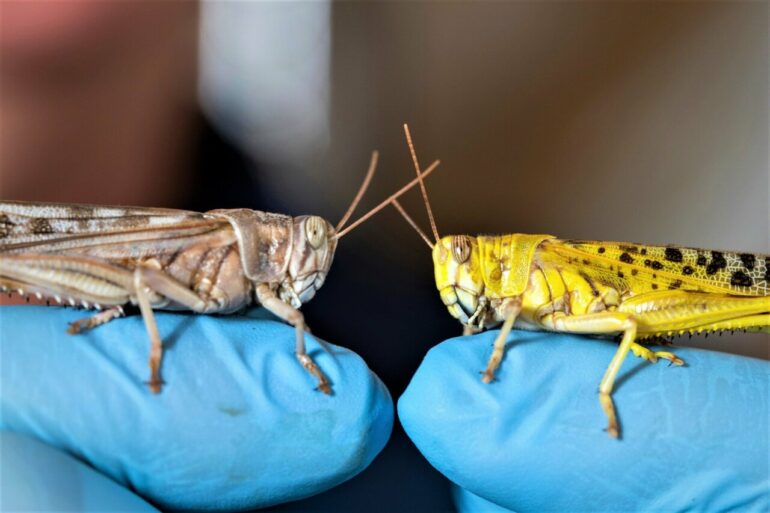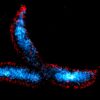A study by a Texas A&M AgriLife Research scientist provides key insights into the changes that occur in locusts that lead to swarms of biblical proportion.
The AgriLife Research study is highlighted in the article “Sexual repurposing of juvenile aposematism in locusts,” published in the Proceedings of the National Academy of Sciences (PNAS).
Greg Sword, Ph.D., AgriLife Research scientist and Charles R. Parencia Endowed Chair in the Department of Entomology, began the study 15 years ago at the University of Sydney in Australia with collaborator Darron Cullen, Ph.D., a zoologist at the University of Lincoln in England. Cullen was Sword’s doctoral student at the time.
Over those 15 years, while working in laboratories at Katholieke Universiteit Leuven, Belgium, and the University of Cambridge, United Kingdom, Cullen manipulated a single protein controlling the locust’s coloration. As the newly published study shows, the gene serves multiple purposes and provides several adaptive functions based on a locust’s age, sex and surrounding population density.
Desert locusts, Schistocerca gregaria, are the locusts of biblical fame. They are a species of grasshopper that exhibit an extreme example of phenotypic plasticity called phase polyphenism, meaning these insects’ behavioral and morphological characteristics can change drastically depending on their population density, said Sword.
Sword is a member of National Science Foundation-funded Behavioral Plasticity Research Institute, a major multi-institution initiative specifically investigating locust phenotypic plasticity.
The publication reveals a previously unknown sexual dimension to desert locusts’ phase polyphenism, Cullen said. The findings suggest that locusts represent a model for investigating the contributions of natural versus sexual selection in the evolution of phenotypic plasticity.
“Basically, it is males signaling males in the chaos of the swarm, ‘Look, I am a male, and there is no point of jumping on me because you’d be wasting your time and energy,'” Cullen said. “The males benefit from this cooperative avoidance mechanism, so they focus their efforts on females for mating success.”
Identifying the gene that triggers color change
Lone-living, “solitarious,” locusts shift towards the “gregarious phase” at higher population densities. Gregarious locusts are more active and socially cohesive, and their color pattern changes, Sword said.
“The behavioral and other changes are radical,” he said. “That’s why people once believed they were actually different species, but it’s just these behavioral and morphological changes that are triggered by population densities that can ultimately lead to massive swarms of locusts.”
Juvenile locusts in low population densities are green or sand-colored, which matches their background for camouflage, he said. But at high densities they change to a contrasting yellow and black aposematic coloration meant to deter predators. Upon reaching adulthood, high density locusts reset towards a dull brown color, but a few days later the males turn bright yellow.
Sword and Cullen’s recent study shows that the same “yellow protein” gene, expressed in both males and females as juveniles, is being re-used as a signal between males in swarming conditions.
The role of ‘yellow protein’
The predominant green or sand-yellow background colors of these grasshoppers depend on the expression of a carotenoid-binding “yellow protein,” Sword said.
By using RNA interference, Cullen, Sword and the other collaborators determined that gregarious male yellowing acts as a warning to prevent mistaken sexual harassment of other males.
Cullen said they also tested to see if coloration was a signal to females that males were fit mates, but it made no difference in females’ mate choice.
“They need to use their limited energy effectively in a swarming environment,” Cullen said. “The coloration is a signal that reduces the confusion and increases mating success in the middle of a swarm.”
Fundamental locust study could guide research, control methods
Sword and Cullen believe the novel research focused on a fundamental role in the solitarious-to-gregarious change could lead to better control methods and prevent devastation by swarms.
In 2020, swarming locusts in Eastern Africa threatened the livelihoods of 10% of the world’s population as they swept across the Middle East and southwest Asia, causing billions of dollars in agriculture damage and leaving millions of people facing famine.
Swarms are unpredictable forces of nature, Sword said, but understanding how these grasshoppers and their environment create conditions for them to change into locusts could help predict population surges and develop control methods to interrupt the change or intervene before they swarm.
Scientists have known about the color change in male locusts for more than 100 years, but the discovery of a single gene that controls coloration is a key step to answering fundamental questions about locusts, Sword said.
“This is foundational information, and we don’t want to get ahead of ourselves with broader applications,” Sword said. “But we often talk about understanding behavior, and this is in regard to sexual behavior, which leads to more locusts. So, trying to understand their behavior is a step in the right direction toward solving problems related to locust swarms.”
More information:
Darron A. Cullen et al, Sexual repurposing of juvenile aposematism in locusts, Proceedings of the National Academy of Sciences (2022). DOI: 10.1073/pnas.2200759119
Provided by
Texas A&M University
Citation:
Study identifies sex-adapted color-change gene in locusts (2022, August 25)



